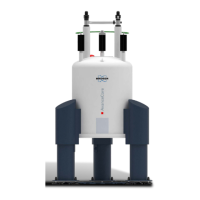Safety
H157654_9_011 13 / 120
The next table shows the maximum retention periods within different fringe field regions be-
low 5 Tesla for standard precautionary situations. The corresponding spatial regions within
and around the super-conducting magnet can be worked out from the fringe-field plots of the
magnet being used.
Magnetic Flux Retention Period Parts of the Body
5T < 20 Minutes Extremities
4T < 25 Minutes Extremities
3T < 34 Minutes Extremities
2T < 52 Minutes Head/Body
1T < 1 Hour 42 Minutes Head/Body
0.5T < 3 Hours 23 Minutes Head/Body
0.3T < 5 Hours 39 Minutes Head/Body
We do not take any responsibility for the numbers given in this table!
Table2.3: Example of Maximum Retention Periods
If higher field strength is accessible inside the magnet by a user’s extremities, a correspond-
ing table for non-standard situations can be worked out from the table above. However, the
analysis must be carried out in a more detailed and differentiated manner and a greater num-
ber of more important conditions must be strictly fulfilled.
General Public Exposures – Electromagnetic Fields and Public Health
Based on scientific knowledge on the direct effects of static fields on humans, acute exposure
of the general public should not exceed 400 mT (any part of the body). However, because of
potential indirect adverse effects, ICNIRP recognizes that practical policies need to be imple-
mented to prevent inadvertent harmful exposure of people with implanted electronic medical
devices and implants containing ferromagnetic materials, and injuries due to flying ferromag-
netic objects, and these considerations can lead to much lower restriction levels, such as 0.5
mT (IEC 2002). The exposure limits to be set with regards to these non-biological effects are
not, however, the duty of ICNIRP (extract from ICNIRP Guidelines published 2009).
With reference to the WHO (World Health Organization – see www.who.int/emf), it is not pos-
sible to determine whether there are any long-term health consequences even from exposure
in the milli-Tesla (mT) range because, to date, there are no well-conducted epidemiological or
long-term animal studies. Thus, the carcinogenicity of static magnetic fields to humans is not
at present classifiable (IARC, 2002).
European Community Directive
The European Community did release a Directive 2004/40/EC on the minimum health and
safety requirements regarding the exposure of workers to the risks arising from physical
agents (electromagnetic fields).
This directive, depending on the frequency, specifies the following limits of exposure to elec-
tromagnetic fields:
Frequency Range Magnetic Field Strength H Magnetic Flux Density B
0…1 Hz 1.63 x 10
5
A/m 0.2 T or 200 mT
This specification and the following more detailed national regulations are an example that
fulfills the requirements defined and valid within the EU. Depending on the country where the
system is being installed, it is necessary to clarify the country specific or local regulations with
respect to exposure and safety in magnetic fields.
